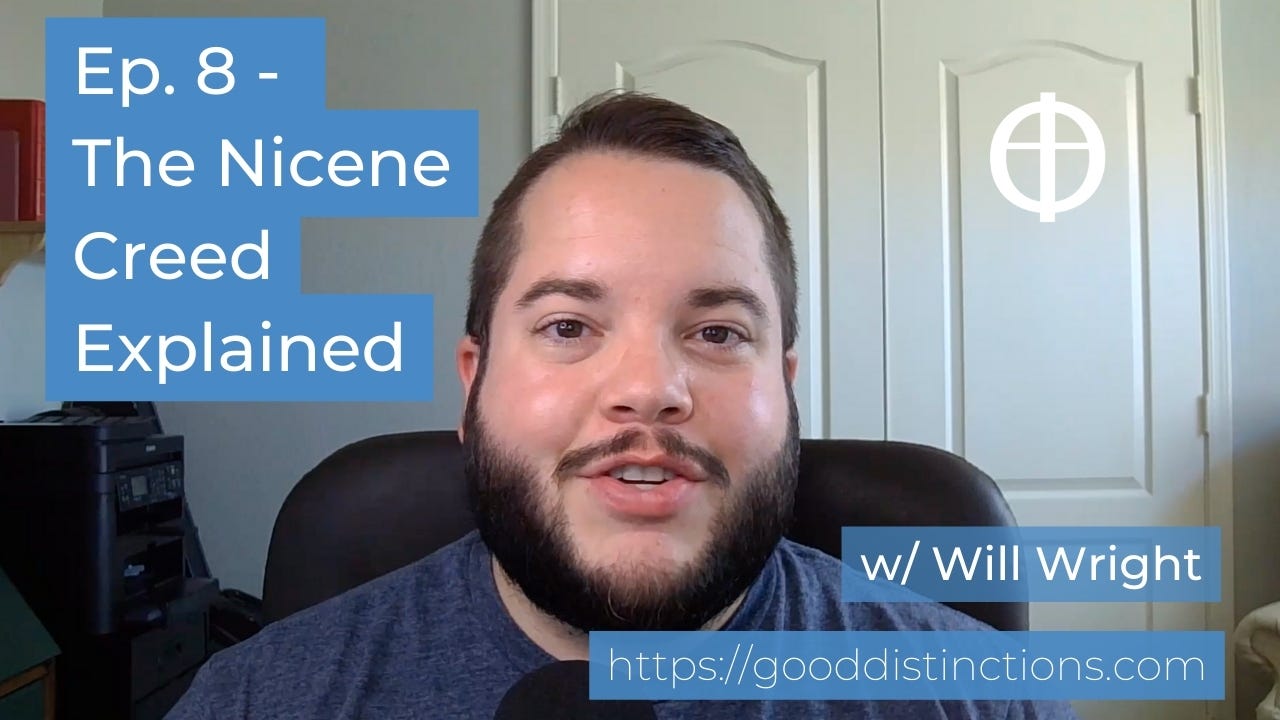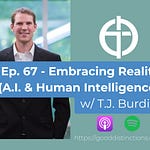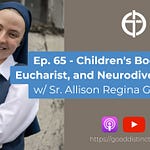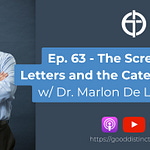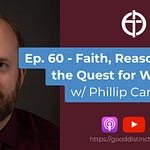Introduction
Welcome back to Good Distinctions! Before we begin, I want to invite you to consider contributing financially to Good Distinctions. Good distinctions are the spice of life, and Teresa and I are enjoying producing content, finding good distinctions, igniting conversation, and inviting you all to do likewise! In order to continue, we need your help. Consider becoming a paid subscriber and show your support for as little as $5/month by clicking subscribe at gooddistinctions.com
In today’s episode, we will take a quick walk through the Nicene Creed to examine what Catholics believe! Of course, the Catechism of the Catholic Church does a much better job than I will do here. And there are books that provide an even deeper dive. My goal here is to provide a 30,000 foot view of the Nicene Creed, the Symbol of Faith.
The Creed has been referred to from ancient times as a Symbolon. The Greek word Symbolon means to “throw together” - the Creeds, as Symbols of Faith - draw the followers of Christ together in like belief. Scott Hahn, in his book on the Creed, refers to the recitation of the Nicene Creed at Holy Mass during the Liturgy of the Word as analogous to receiving Holy Communion during the Liturgy of the Eucharist. In our public recitation of belief, we identify ourselves boldly as Christians in union with those around us and all those who have come before.
The Niceno-Constantinopolitan Creed
The Nicene Creed, technically called the Niceno-Constantinopolitan Creed, is professed every Sunday at Mass in the Latin Rite of the Catholic Church. In the Eastern Rites of the Catholic Church and in our separated Orthodox brethren, this same Creed is professed in its original formulation.
The only difference between the Creed of the East and West is the later addition of the phrase “and the Son” to the paragraph on the procession of the Holy Spirit. Unfortunately, this disagreement has caused great difficulty and division between Eastern and Western Christianity.
The Nicene Creed arose from the first two ecumenical councils of the Church. The first ecumenical council is the First Council of Nicaea in 325 A.D. and the second is the Council of Constantinople in 381 A.D. This Creed is ancient and it has preserved the faithful from a variety of heresies for over 1,600 years. To understand it is to understand what we believe as Catholics.
Walking through the Creed
Let’s take a quick walk through the Creed and try to understand it a bit more in depth. Of course, each word in the phrase is packed with meaning and endless depth. Truly, the reality of our Faith is that we are diving into the mysteries of an infinite God. So, there is always more to learn.
Paragraph 1 – God the Father
I believe in one God, the Father almighty, maker of heaven and earth, of all things visible and invisible.
We believe in one God in three Persons. We do not believe in three gods. Our one God is not only our king and Lord, He is our Heavenly Father. We are His adopted son or daughter through Baptism. He created everything that we can see, but He also created all the things that we cannot see. For example, we believe in the angels, in our own souls, and in demons. God is Lord over all of it and has all might.
Even though He is tremendously powerful, our God and Father draws us into a relationship with Him and invites us to share eternal blessedness in another invisible reality: Heaven.
Paragraph 2 – The Lord Jesus
I believe in one Lord Jesus Christ, the Only Begotten Son of God, born of the Father before all ages. God from God, Light from Light, true God from true God, begotten, not made, consubstantial with the Father; through him all things were made. For us men and for our salvation he came down from heaven,
The Second Person of the Blessed Trinity is the Word of God, the Son of God. This Word of God, Jesus Christ, proceeds from the Father. He was “born” and “begotten” but not made. This is a mystery that is very difficult to understand. Much ink has been spilled in theology on how Jesus can be both God and man.
In other words, Jesus is fully God and He is eternal, just as the Father is eternal. This paragraph emphasizes that there is one God but the Father is nonetheless distinct as a Person from the Person of the Son. Though distinct Persons, these Persons share in the one metaphysical “substance” of the Godhead. This is what the word “consubstantial” means - the Son being of one substance with the Father. In others, the Person of the Son and the Person of the Father share in the one, same Divine Nature.
The Council Fathers went to great lengths to combat the Arian heresy which claimed that Jesus was created and was not truly God. We believe that Jesus is fully God and fully man. As the Word of God, He has existed forever and will always exist. He proceeds from the Father as God from God and Light from Light, true God from true God. I will go into more detail on this in the fifth paragraph on the Holy Spirit.
There is also the realization that it is through the Word of God that all things were made. God reveals to us in Genesis God speaks in order to create. He says, “Let there be light.” And there was light. Jesus Christ, the Word of God, was sent on a mission by the Father to come down from heaven in order to redeem humanity and offer us salvation.
Paragraph 3 – The Incarnation and The Virgin Mary
and by the Holy Spirit was incarnate of the Virgin Mary, and became man.
By the free choice of Mary, our Mother, and by the power of the Holy Spirit, the Word of God took on flesh. Jesus Christ, the uncreated Word through which all things were made, condescended to share in our humanity. The almighty God emptied Himself and took on the form of a slave, to use the language of St. Paul.
In the Latin Rite, there is a tradition of bowing during this paragraph in honor of the Incarnation. During the Liturgies for Christmas and the Feast of the Annunciation, we kneel down during this phrase when we recite the Creed. In the Roman Missal of 1962 and before, this practice of kneeling happens at every single Mass during the Last Gospel when the phrase “the Word was made flesh and dwelt among us” from John chapter 1 is uttered. If you have attended the Latin Mass, then you will be familiar with hearing the words “et Verbum caro factum est” and genuflecting. The Incarnation is literally the “enfleshment” of Jesus; it is what we celebrate at Christmas. This paragraph marks one of the most important moments in human history. Our God became one of us.
Paragraph 4 – The Paschal Mystery
For our sake he was crucified under Pontius Pilate, he suffered death and was buried, and rose again on the third day in accordance with the Scriptures. He ascended into heaven and is seated at the right hand of the Father. He will come again in glory to judge the living and the dead and his kingdom will have no end.
This paragraph is directly connected to the previous. Jesus became man in order to accomplish the work of our salvation. It was for each of us that Jesus was crucified. The Council Fathers include “under Pontius Pilate” to show that this was an historical reality. It really happened. So too, Jesus truly rose from the dead on the third day after being buried.
Forty days after rising from the dead, He lifted Himself up into Heaven in a mysterious fashion and He now reigns in Heaven as King at the right hand of the Father. We believe that He will come again in glory. This is what we call the Second Coming. At the second coming of Christ, we will all be judged; everything we have done will be laid bare and true justice will be accomplished.
This second coming will result in the passing away of the old Heaven and the old Earth and the establishing of Jesus’ everlasting kingdom.
Paragraph 5 – The Holy Spirit
I believe in the Holy Spirit, the Lord, the giver of life, who proceeds from the Father and the Son, who with the Father and the Son is adored and glorified, who has spoken through the prophets.
We believe in one God in three Persons. The third Person of the Trinity is the Holy Spirit, who we also rightly call Lord and the giver of life. God breathed life into the first man, after all. This holy breath of God is the Spirit which gives life and sustains life. He is glorified and loved as God, along with the Father and the Son. We believe that the Holy Spirit, before the Incarnation as well as after, inspired the prophets.
The Trinity is the mystery of God, as He is. It is difficult to wrap our minds around this mystery in any meaningful way. Our metaphors are usually material, like a three-leaf clover or the states of water as ice, liquid, or vapor, and because they are material, they always fall short. God is spiritual, not material. The best explanation I have heard of the Blessed Trinity is from St. Augustine’s Analogy of the Mind. I will try my best to offer a simplified version. Though, it is far from simple. And remember, this is an analogy.
In our own minds, we have intellect and will. We know things and act freely. When we learn or know things, we have a procession of the intellect. When we act freely upon ourselves or the world, we have a procession of the will. If we analogously apply this understanding to the “mind of God,” we see a procession of the intellect and a procession of the will. God is perfect and so these processions must be infinite and perfect.
The procession of the intellect, within the mind of God, is God the Father’s perfect knowledge of Himself. This perfect image of Himself is the Son. The Son, in return, perfectly loves the Father. God is love. Therefore, the procession of His will is perfect love which proceeds as the love shared between the Father and the Son. This is the Holy Spirit. However, we must understand that He does not proceed in time, as He is as eternal as the Father and the Son.
Paragraph 6 – The Church
I believe in one, holy, catholic and apostolic Church. I confess one Baptism for the forgiveness of sins and I look forward to the resurrection of the dead and the life of the world to come.
The Church of Jesus Christ is His Mystical Body. Before being an institution of human beings, the Church is divinely constituted. In other words, the Church was begun by the action of the Holy Trinity, is sustained by the Holy Trinity, and is ordered towards the Holy Trinity. Therefore the Church is holy, even if the human beings who compromise it are not always holy. The Church is one because Christ is one. She is also one in her teaching, preaching, governance, and means of sanctification. The Church is catholic because the Church is “universal.” Catholic means universal - the Greek is kata holon which means “according to the whole.” And the Church is apostolic because Christ founded it upon the Apostles and apostolic teaching and continued in governance and preaching by their successors.
We enter into this Church through the one Baptism of Christ, by which we are cleansed of original sin, are grafted into Christ, and become adopted sons and daughters of God.
We believe that when Christ comes again, we will be reunited with our bodies in a glorified way, similar to Christ’s resurrected Body. We do not know exactly what this will look like.
And we look forward to the life of the world to come which is eternal blessedness in the company of the angels and the saints in constant praise and love of God. We will want for nothing and all suffering will be no more.
Paragraph 7 - Amen
Amen.
And finally… amen! Amen means “yes,” “so be it,” and “I believe.” It is the only ending to the Creed that we can offer as human beings. God has revealed all He is and all that He has done for us, and our confident and faithful “Amen” is the response of our heart. We should also keep in mind that the Creed does not exist apart from the Sacred Liturgy. The entire Liturgy of the Word, and especially the Creed, is preparing us for the Liturgy of the Eucharist.
In the Second Century, St. Justin Martyr writes in his Apologia that after the prayers of thanksgiving and consecration were finished by the priest, all responded by saying “Amen.” This is not simply a word found at the end of a conversation. It is not like saying, “Ok. Goodbye, God,” after a prayer is finished. St. Paul writes, “Otherwise, if you give thanks with your spirit, how can anyone in the position of an outsider say “Amen” to your thanksgiving when he does not know what you are saying?” So, it would seem that the word Amen packs a punch. But what does it mean?
Amen is a Hebrew word which means “so be it.” St. Augustine translated it as “it is true (Latin: verum est).” In a tract explaining the Mass from the Middle Ages, we read, “Amen is a ratification by the people of what has been spoken, and it may be interpreted in our language as if they all said: May it so be done as the priest has prayed (Catholic Encyclopedia, 1907).”
It is custom in most of the Rites of the Catholic Church, both East and West, to say “Amen” after receiving Holy Communion. In the Missale Romanum of 1962, the priest says, “Corpus Domini Nostri Iesu Christi custodiat animam tuam in vitam aeternam, Amen (May the Body of our Lord Jesus Christ preserve your soul unto life everlasting. Amen).” So, even though the communicant does not say “Amen” like in the Missale Romanum of 1970, the priest has said “Amen” for them.
The language of “Amen” seems to be like a contract. When two people enter into an agreement with one another, they may mark it with a handshake and say, “so be it” or “I agree.” Is that what is happening at Mass? Certainly, what we are entering into at Mass is far more important, meaningful, lasting, and beautiful. Perhaps more than a contract, the “Amen” shows us that the language of the Mass is that of a covenant. A contract can be broken. A covenant cannot be broken.
When we approach our Lord Jesus Christ in the Holy Eucharist, we are approaching the Bridegroom as the Bride. We are uttering our wedding vows to the King of Heaven each time we receive Holy Communion. We are saying, “I do” when we say “Amen.” The meaning of the word is very close to this understanding. We are using the language of marriage to show that we are accepting the Bridegroom into our body and soul to remain with us always. As husband and wife become one flesh in marriage, the communicant and our Lord become one in the Eucharist. “Communion” means “one with.” We are becoming more closely joined to the Lord in reception of Holy Communion.
Every time we say “Amen” we should clearly state what we are doing. We are giving our assent of Faith. We are not saying “Okay” or “Sure”, we are saying “so be it.” Do we know what we are saying “yes” to? Do we know what we are entering into? Our “yes” to God cannot be half-hearted or wishy-washy. It must be sure and resolute, by His grace. Our Lord Jesus is a strong proponent of authenticity and resolution. We hear in the Book of Revelation: “So, because you are lukewarm, and neither hot nor cold, I will spit you out of my mouth (Rev. 3:16).” And in the Gospel of St. Matthew: “Let what you say be simply ‘Yes’ or ‘No’; anything more than this comes from evil (Mt. 5:37).” Let our Amen mean Amen.
Conclusion
I hope this brief reflection has been a help to you. Ideally, we will all continue to grow in our knowledge, love, and service of the Lord until the glorious day when we will see Him face to face in Paradise, God willing.
Having the right belief on matters of doctrine is not a matter of triumphalism that we should lord over others. In humility and gratitude, we should accept this ancient formulation and symbolon and allow Jesus to enter us ever more fully into the heart and mind of the Church.
If you have enjoyed this episode and feel that it has been a help to you, please share it on your own personal social media. And more importantly than that, please consider sharing Good Distinctions with 2-3 people at church or at work in person this week. The sort of topics that we are dealing with are universally applicable and should be of benefit to anyone and everyone. Also, if you are listening to this episode on Apple Podcasts or Spotify, please follow the show and leave a rating and review, that tells the algorithm that more people should listen to Good Distinctions. On YouTube, the best thing you can do is subscribe to the channel, like the episode, and leave a comment. If you are listening natively on Substack and you use Notes, please consider restacking this episode, liking it, or sharing it on your social media.
Just a note on Substack - if you have not subscribed at gooddistinctions.com, please consider doing so. Besides the weekly video and audio episodes, we will be releasing quite a bit more written content (short Scripture reflections, commentaries on current events, or little reflections on various topics). You won’t want to miss out on that. And as I said at the top of the show, if you believe in what Teresa and I are doing here at Good Distinctions, please consider becoming a paid subscriber for as little as $5/month to support our mission. We believe that good distinctions are the spice of life, of course. But our mission is this: to seek out the best distinctions, to reignite good conversations, and inspire others to do the same.
Thanks for listening, reading, and watching. Good Distinctions are the Spice of Life! To end today, please join me in praying through the Nicene Creed.
The Nicene Creed
I believe in one God, the Father almighty, maker of heaven and earth, of all things visible and invisible.
I believe in one Lord Jesus Christ, the Only Begotten Son of God, born of the Father before all ages. God from God, Light from Light, true God from true God, begotten, not made, consubstantial with the Father; through him all things were made.
For us men and for our salvation he came down from heaven, and by the Holy Spirit was incarnate of the Virgin Mary, and became man.
For our sake he was crucified under Pontius Pilate, he suffered death and was buried, and rose again on the third day in accordance with the Scriptures. He ascended into heaven and is seated at the right hand of the Father. He will come again in glory to judge the living and the dead and his kingdom will have no end.
I believe in the Holy Spirit, the Lord, the giver of life, who proceeds from the Father and the Son, who with the Father and the Son is adored and glorified, who has spoken through the prophets.
I believe in one, holy, catholic and apostolic Church. I confess one Baptism for the forgiveness of sins and I look forward to the resurrection of the dead and the life of the world to come.
Amen.



